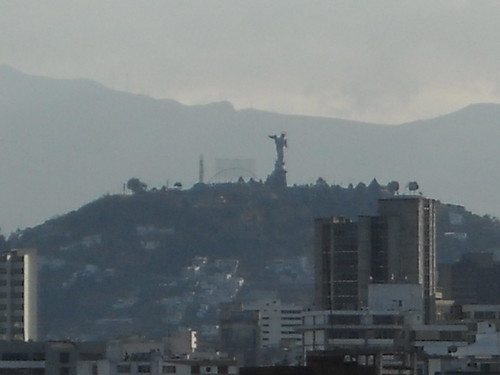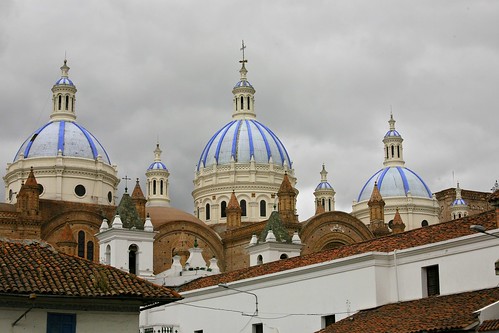
Photography by Peter Shanks
Nestled amid the mountains of Ecuador, Quito and Cuenca are two of the best preserved colonial cities in South America. With style, each attracts visitors for its art, architecture and history.
One of the favorite pastimes of the Ecuadorian visitors is to ask what city they found their most beautiful country: Quito, the capital of the clouds, and Cuenca, the Athens of the Andes? If title is, both boast a vast collection. Quito is considered the heart of the Ecuadorian national shrine by his mixed and art history in America, while Cuenca received the title of cultural capital of the Americas for a long intellectual tradition. To maintain the balance in equilibrium, the UNESCO declared Heritage of Humanity by the impeccable preservation of its colonial past.
But Quito and Cuenca are only two colonial cities. While what stands out and apart from the rest of the cities of the continent is the architecture that have been preserved until today, its history dates back to centuries before the Spanish colonization. And to understand the cultural fusion that occurs in these two cities is necessary to look beyond the European and Latin American actually find what has survived and strengthened over time. Because in the areas of Quito and Cuenca settlements existed long before its formal foundation: Basin was inhabited by the tribe and named Guapondelig Canari (plain wide as the sky, in local dialect), and Quito was inhabited by the Quitus, a indigenous merchants.
Both areas were conquered by the Incas and became two of the most important cities of the empire. The arrival of the Spanish was strongly resisted by the sons of the sun, who preferred to burn their own cities rather than let the invaders advance on them. Thus, San Francisco de Quito was founded on the ashes of the old Inca city and Cuenca, named after the Spanish city, was also built on its ancient ruins.
Modern Quito:
The capital of the clouds:
Quito dazzle at first glance. The landscape in which it is found perfectly preserved architecture and the large number of tourists from all over the world is more than what is expected of a city that seems to be hidden among the mountains. Nestled in an Andean valley, surrounded by the Pichincha volcano (still active) and Atacazo Casitagua and 2850 meters high, the capital of Ecuador has «foot in the forest and head in the clouds.» The city is divided into three sectors: in the north sits the modern Quito, the South is made up of working-class housing and the center is preserved old town, the historic center of America’s largest, with 320 hectares .
In 1978, Quito and Krakow (Poland) were the first cities to be declared Cultural Heritage of Humanity by UNESCO for its «outstanding universal value.» It turns out that the historical, legacy of the colonial period, is designed according to the Spanish of the time parameters. So, walk through the narrow streets amounts to be transported to another century, where the architecture of churches, plazas, museums and houses are mixed with the idiosyncrasies of the mountains of Ecuador.
The buildings are arranged around the Plaza Grande by is the Government Palace, the oldest cathedral in South America and the Monument to Independence. Also retain more than 130 buildings and art monuments appears both inside and outside of buildings. Each building has its own style religious: the Capilla del Señor Jesús del Gran Poder, for instance, has a baroque altar, while the Society of Jesus has walls, roof and altar decorated with seven tons of gold. But one of the most impressive is the Basilica del Voto Nacional: located in a hill 115 meters high, has been compared to Notre Dame Cathedral (Paris) and the Basilica of San Patricio (New York) for their structure and Gothic. The funny thing is that the typical gargoyles were replaced by sculptures arranged on reptiles and amphibians stone roses representing the fauna and flora of Ecuador.
Once you cross the tunnel that separates Quito Quito’s Old Modern, the visitor returns to travel forward in time. The adobe houses, the central sources of parks, narrow streets and churches are replaced by a cosmopolitan flavor.
The area began to grow in the 70s, when mutated residential space in the shopping area. Here is spread chaos known Latin: the comings and goings on the trolley, the Ecovia and the Metrobus (the three main transport to move) and the flow of people do that the pace of life more rapidly. La Mariscal, the neighborhood of choice for tourists, is the ideal area to test the cuisine of the city.
Another way to know a country is through its artists. Two of the most representative Latin American Indian art were Camilo Egas, painter made in Ecuador and in major European academies, and Oswaldo Guayasamin expressionist whose art was awarded the highest award granted by the government of Ecuador. Much of his work can be seen in the eponymous museum in the modern sector of the city, and his latest work, the Chapel of Man, is a great monument-museum built by the artist as a tribute to Latin America.
For those seeking a privileged view of the city, just go to the Panecillo , a natural viewpoint to three thousand meters high, was in pre-Inca times, a temple dedicated to the worship of the sun. There is the increased representation of the Virgin Mary in the world, made of aluminum. And the cable car that travels 2500 meters up to Cruz Loma, one of the Pichincha volcano, is another option to visit Quito from the sky.

Photography by Peter Shanks
Cuenca:
The Athens of the Andes
In the south, and ten hours by land or 45 minutes by plane from Quito, another lost city in the mountains, the third largest in the country and the first for many in beauty. Also declared Cultural Heritage of Humanity by impeccably preserved its colonial heritage, one can breathe a different atmosphere, more than people. Surrounded by rivers and 2,500 feet, Santa Ana de los Cuatro Ríos de Cuenca is well deserved the title of colonial jewel. The four rivers that cross Cuenca give a movement that contrasts with the tranquility of a place that seems to have been frozen in time.
Tomebamba The river divides into two: the south rises the modern residential area on the north, the historic center, which remains the heart of the city. This map is not needed. The slogan is let go and always looking up: the colonial buildings are high and the most impressive are at the top. And for those who prefer to look down, just go to the viewpoint of Turi and observe the peaceful and quiet city from the side of a mountain.
Cuenca is considered, with pride, the Athens of the Andes for its intellectual tradition and for being the birthplace of writers, poets, artists, musicians and philosophers remarkable. It is also a craft center internationally recognized for his work in ceramics, leather, gold and silver.
The Cuenca, Ecuador famous for his peculiar accent (similar to Argentina’s Salta), profess a religious faith notable: in the city has 52 churches and monasteries (one for each Sunday of the year). Here, too, feels the merger between the European and Latin American: architectural and urban links, save the appearance of a Spanish city, though the materials used to erect were typically Indian (adobe, straw, wood and clay). What’s more, its 400 000 inhabitants are loyal to their roots, so crossing is very common with the traditional Indian women dressed in skirt, blouse embroidered cloth, hat and patent leather shoes, selling flowers in the parks and markets.

Photography by Peter Shanks
Climate:
In the mountains is better to go from May to September and from December to February, the weather is drier in that season. The rest of the year is rainy season. In both cities the temperature is stable (between 8 º C and 23 º C), with strong fluctuations between day and night.
Height:
Quito and Cuenca are over 2,800 meters high. During the first few days is recommended activities slowly and drink plenty of water.
Currency: U.S. dollar is in force. Attention, because the tickets u $ 50 u $ 100 have poor circulation and, in general, are not accepted.
Bon voyage!
Leave a Reply
You must be logged in to post a comment.
Recent Comments